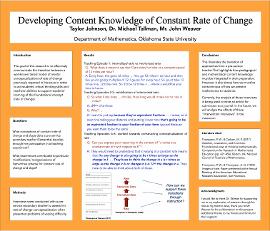| dc.contributor.advisor | Tallman, Michael | |
| dc.contributor.author | Johnson, Taylor | |
| dc.contributor.other | Weaver, John | |
| dc.date.accessioned | 2022-04-19T13:18:56Z | |
| dc.date.available | 2022-04-19T13:18:56Z | |
| dc.date.issued | 2022-04-19 | |
| dc.identifier | oksd_URS_2022_johnson | |
| dc.identifier.citation | Johnson, T., Tallman, M., & Weaver, J. (2022, April 19). Developing content knowledge of constant rate of change. Poster session presented at the Oklahoma State University Undergraduate Research Symposium, Stillwater, OK. | |
| dc.identifier.uri | https://hdl.handle.net/11244/335249 | |
| dc.description.abstract | A mathematics teacher's instruction is informed by their pedagogical knowledge (teaching theories and tactics) and content knowledge (ability to solve and understand math problems). A successful teacher must utilize both of these knowledge bases to support students' conceptual learning of mathematics. Rate of change is one of the foundational topics within mathematics - it is essential to understanding function properties and representations and is the basis for calculus and differential equations. Ideally, one would apply covariational reasoning to develop a productive conception of constant, average, and instantaneous rate of change. Covariational reasoning, refers to the cognitive actions occurring when an individual relates the way two varying quantities change together. Previously conducted interviews by my research mentors were recorded and are now being analyzed to determine how the subject's meanings for constant rate of change progressed and to discern how the subject's learning was influenced by her covariational reasoning. During the interviews, the participant was given increasingly more difficult rate of change problems to solve and discuss. At times, she struggled to solve a new problem using the methods she had previously employed. However, she also had moments of growth in her reasoning and problem-solving approaches. We hope to distinguish and emphasize the differences between her approaches to solving constant rate of change problems. The goal of this journal submission is to effectively communicate the transition between a well-known tiered model of mental conceptualizations of rate of change previously reported in literature in order to aid students' critical thinking skills and teachers' abilities to support students' learning of this foundational concept. This journal article will also illustrate how teachers must recognize possible misconceptions that may be developed through the introduction of rate of change; they are not always obvious until later when more complex problems are introduced but a student defaults to what they are comfortable with. By being conscientious of the relationships within covariational reasoning, teachers can aid in students' understanding in their class and the students' future mathematics courses as well. | |
| dc.description.sponsorship | Oklahoma State University. Freshman Research Scholars Program | |
| dc.format | application/pdf | |
| dc.language | en_US | |
| dc.publisher | Oklahoma State University | |
| dc.rights | In the Oklahoma State University Library's institutional repository this paper is made available through the open access principles and the terms of agreement/consent between the author(s) and the publisher. The permission policy on the use, reproduction or distribution of the article falls under fair use for educational, scholarship, and research purposes. Contact Digital Resources and Discovery Services at lib-dls@okstate.edu or 405-744-9161 for further information. | |
| dc.title | Developing content knowledge of constant rate of change | |
| osu.filename | oksd_URS_2022_johnson.pdf | |
| dc.description.department | Mathematics | |
| dc.type.genre | Poster | |
| dc.type.material | Text | |
| dc.type.material | Image | |
| dc.subject.keywords | mathematics | |
| dc.subject.keywords | education | |
| dc.subject.keywords | pedagogy | |
| dc.subject.keywords | rate of change | |
